Fatigue Fracture Characteristics of Ti6Al4V Subjected to Ultrasonic Nanocrystal Surface Modification
Abstract
:1. Introduction
2. Experimental Procedures
3. Results and Discussion
3.1. Observation of the Severe Plastic Deformation Layer
3.2. Hardness and Residual Stress Distrubutions
3.3. Surface Topography
3.4. Fatigue Fracture Characteristics
4. Conclusions
- UNSM technique improves the microhardness and the surface compressive residual stress of TC4. The ultrasonic surface impact helps to achieve a regular surface, almost without changing the surface roughness.
- The fatigue strengths of TC4 subjected with two different heat treatments are improved by 7% (to stress-relief annealing) and 11.7% (to solid solution-aging), respectively.
- After UNSM, fatigue cracks mainly initiate from the surface of the specimen before the fatigue life of 106 cycles, while they appear at the internal compress deformed α-phase at the zone between the SPD layer and the core after the fatigue life of 106 cycles. The shapes of crack cores are long and narrow because of the ultrasonic impacts on the surface.
- The dimples change from equal-axis ductile voids to be parabolic fossae and oval toughening nests due to the dimensional change of the grains.
- The stress intensity factor calculated from the facet area ΔKfacet was in the range of 8.3–10.0 MPa·m1/2. The slip of the deformed α phase induces the propogation of microcracks.
- The energy field of crack evolution depends on both the deformed crystal slip and the surface remodeling.
Acknowledgments
Author Contributions
Conflicts of Interest
References
- Lu, K.; Lu, J. Nanostructured surface layer on metallic materials induced by surface mechanical attrition treatment. Mater. Sci. Eng. A 2004, 375–377, 38–45. [Google Scholar] [CrossRef]
- Maawad, E.; Sano, Y.; Wagner, L.; Brokmeier, H.-G.; Genzel, C. Investigation of laser shock peening effects on residual stress state and fatigue performance of titanium alloys. Mater. Sci. Eng. A 2012, 536, 82–91. [Google Scholar] [CrossRef]
- Cain, V.; Thijs, L.; Van Humbeeck, J.; Van Hooreweder, B.; Knutsen, R. Crack propagation and fracture toughness of Ti6Al4V alloy produced by selective laser melting. Addit. Manuf. 2015, 5, 68–76. [Google Scholar] [CrossRef]
- Yu, S.; Liu, D.; Zhang, X.; Du, D. Effects of combined plasma chromizing and shot peening on the fatugue properties of a Ti6Al4V alloy. Appl. Surf. Sci. 2015, 353, 995–1002. [Google Scholar] [CrossRef]
- Tang, C.; Liu, D.; Tang, B.; Zhang, X.; Qin, L.; Liu, C. Influence of plasma molybdenizing and shot-peening on fretting damage behavior of titanium alloy. Appl. Surf. Sci. 2016, 390, 946–958. [Google Scholar] [CrossRef]
- Simonelli, M.; Tse, Y.Y.; Tuck, C. Effect of the build orientation on the mechanical properties and fracture modes of SLM Ti-6Al-4V. Mater. Sci. Eng. A 2014, 616, 1–11. [Google Scholar] [CrossRef]
- Batory, D.; Szymanski, W.; Panjan, M.; Zabeida, O.; Klemberg-Sapieha, J.E. Plsma nitriding of Ti6Al4V alloy for improved water erosion resistance. Wear 2017, 374–375, 120–127. [Google Scholar] [CrossRef]
- Liu, W.Y.; Lin, Y.H.; Chen, Y.H.; Shi, T.; Ambrish, S. Effect of different heatments on microstructure and mechanical peoperties of Ti6Al4V titanium alloy. Rare Met. Mater. Eng. 2017, 46, 634–639. [Google Scholar]
- Chen, S.X.; Usta, A.D.; Eriten, M. Microstructure and wear resistance of Ti6Al4V surfaces processed by pulsed laser. Surf. Coat. Technol. 2017, 315, 220–231. [Google Scholar] [CrossRef]
- Lu, K.; Lu, J. Surface nanocrystallization (SNC) of metallic materials-presentation of the concept behind a new approach. J. Mater. Sci. Technol. 1999, 15, 193–197. [Google Scholar]
- Bloyce, A.; Morton, P.; Bell, T. ASM Handbook; ASM International: Materials Park, OH, USA, 1994; Volume 5, p. 835. [Google Scholar]
- Liu, K.K.; Hill, M.R. The effects of laser peening and shot peening on fretting fatigue in Ti−6Al−4V coupons. Tribol. Int. 2009, 42, 1250–1262. [Google Scholar] [CrossRef]
- Chen, G.; Jiao, Y.; Tian, T.; Zhang, X.; Li, Z.; Zhou, W. Structure, microhardness and damping characteristics of Al matrix composite reinforced with AlCuFe or Ti using ultrasonic impact peening. Surf. Coat. Technol. 2010, 204, 1590–1598. [Google Scholar]
- Chen, G.Q.; Jiao, Y.; Tian, T.Y.; Zhang, X.; Li, Z.; Zhou, W. Effect of wet shot peening on Ti−6Al−4V alloy treated by ceramic beads. Trans. Nonferrous Met. Soc. China 2014, 24, 690–696. [Google Scholar] [CrossRef]
- Srinivasan, S.; Garcia, D.B.; Gean, M.C.; Murthy, H.; Farris, T.N. Fretting fatigue of laser shock peened Ti–6Al–4V. Tribol. Int. 2009, 42, 1324–1329. [Google Scholar] [CrossRef]
- Tsuji, N.; Tanaka, S.; Takasugi, T. Effects of combined plasma-carburizing and shot-peening on fatigue and wear properties of Ti–6Al–4V alloy. Surf. Coat. Technol. 2009, 203, 1400–1405. [Google Scholar] [CrossRef]
- Stanzl-Tschegg, S. Fatigue crack growth and thresholds at ultrasonic frequencies. Int. J. Fatigue 2006, 28, 1456–1464. [Google Scholar] [CrossRef]
- Morrissey, R.; Nicholas, T. Staircase testing of a titanium alloy in the gigacycle regime. Int. J. Fatigue 2006, 28, 1577–1582. [Google Scholar] [CrossRef]
- Sun, W.; Tan, A.W.Y.; Khun, N.W.; Marinescu, I.; Liu, E. Effect of substrate surface condition on fatigue behavior of cold sprayed Ti6Al4V coatings. Surf. Coat. Technol. 2017, 320, 452–457. [Google Scholar] [CrossRef]
- Liu, X.L.; Sun, C.Q.; Hong, Y.S. Effects of stress ratio on high-cycle and very-high-cycle fatigue behavior of a Ti-6Al-4V alloy. Mater. Sci. Eng. A 2015, 622, 228–235. [Google Scholar] [CrossRef]
- Suh, M.S.; Suh, C.M.; Pyun, Y.S. Very high cycle fatigue characteristic of a chrome-molybdenum steel treated by ultrasonic nanocrystal surface modification technique. Fatigue Fract. Eng. Mater. Struct. 2013, 36, 769–778. [Google Scholar] [CrossRef]
- Zhu, K.Y.; Vassel, A.; Brisset, F.; Lu, K.; Lu, J. Nanostructure formation mechanism of α-titanium using SMAT. Acta Mater. 2004, 52, 4101–4110. [Google Scholar] [CrossRef]
- Yasuoka, M.; Wang, P.; Zhang, K.; Qiu, Z.; Kusaka, K.; Pyoun, Y.-S.; Murakami, R. Improvement of the fatigue strength of SUS304 austenite stainless steel using ultrasonic nanocrystal surface modification. Surf. Coat. Technol. 2013, 218, 93–98. [Google Scholar] [CrossRef]
- Klug, H.P.; Alexandrov, L.E. X-ray Diffraction Procedures for Polycrystalline and Amorphous Materials, 2nd ed.; Wiley: New York, NY, USA, 1974; p. 662. [Google Scholar]
- Hall, E.O. The Deformation and Ageing of Mild Steel: III Discussion of Results. Proc. Phys. Soc. 1951, 64, 747–753. [Google Scholar] [CrossRef]
- Wu, B.; Wang, P.P.; Pyoun, Y.S.; Zhang, J.; Murakami, R. Study on the fatigue properties of plasma nitriding S45C with a pre-ultrasonic nanocrystal surface modification process. Surf. Coat. Technol. 2013, 216, 191–198. [Google Scholar] [CrossRef]
- Suh, M.-S.; Pyoun, Y.-S.; Suh, C.-M. Variation of fatigue properties in nanoskinned Ti-6Al-4V—Rotating bending and axial loading tension-compression cycle. Trans. Korean Soc. Mech. Eng. A 2012, 36, 443–449. [Google Scholar] [CrossRef]
- Sola, R.; Poli, G.; Veronesi, P.; Giovanardi, R. Effects of surface morphology on the wear and corrosion resistance of post-treated Nitrided and nitrocarburized 42CrMo4 steel. Metall. Mater. Trans. A 2014, 45, 2827–2833. [Google Scholar] [CrossRef]
- Sola, R.; Poli, G.; Veronesi, P.; Giovanardi, R.; Mamei, S.; Zanotti, A. Effect of surface finishing and post-oxidation atmosphere on the properties of 41CrAlMo7 nitrided steel. Metall. Ital. 2012, 104, 35–40. [Google Scholar]
- Cao, X.J.; Murakami, R.; Pyoun, Y.S. Fatigue properties of a S45C steel subjected to ultrasonic nanocrystal surface modification. Appl. Surf. Sci. 2010, 256, 6297–6303. [Google Scholar] [CrossRef]
- Cao, X.J.; Xu, X.L.; Wang, C.; Pyoun, Y.; Wang, Q. Effect of ultrasonic surface impact on the fatigue behavior of Ti-6Al-4V subject to simulated body fluid. Metals 2017, 7, 440. [Google Scholar] [CrossRef]
- Murakami, Y. Metal fatigue: Influence of micro defect and inclusion; Yokenndo: Tokyo, Japan, 1993. (In Japanese) [Google Scholar]
- Ochi, Y.; Matsumura, T.; Masaki, K.; Yoshida, S. High-cycle rotating bending fatigue property in very long-life regime of high-strength steels. Fatigue Fract. Eng. Mater. Struct. 2002, 25, 823–830. [Google Scholar] [CrossRef]
- Sakai, T.; Sato, Y.; Oguma, N. Characteristic S-N properties of high-carbon-chormium-bearing steel under axial loading in long-life fatigue. Fatigue Fract. Eng. Mater. Struct. 2002, 25, 765–773. [Google Scholar] [CrossRef]
- Zhu, S.-P.; Lei, Q.; Huang, H.-Z.; Yang, Y.-J.; Peng, W. Mean stress effect correction in strain energy-based fatigue life prediction of metals. Int. J. Damage Mech. 2017, 26, 1219–1241. [Google Scholar] [CrossRef]
- Hertzberg, R.W.; Vinci, R.P.; Hertzberg, J.L. Deformation and Fracture Mechanics of Engineering Materials, 5th ed.; Wiley: Hoboken, HJ, USA, 2012. [Google Scholar]

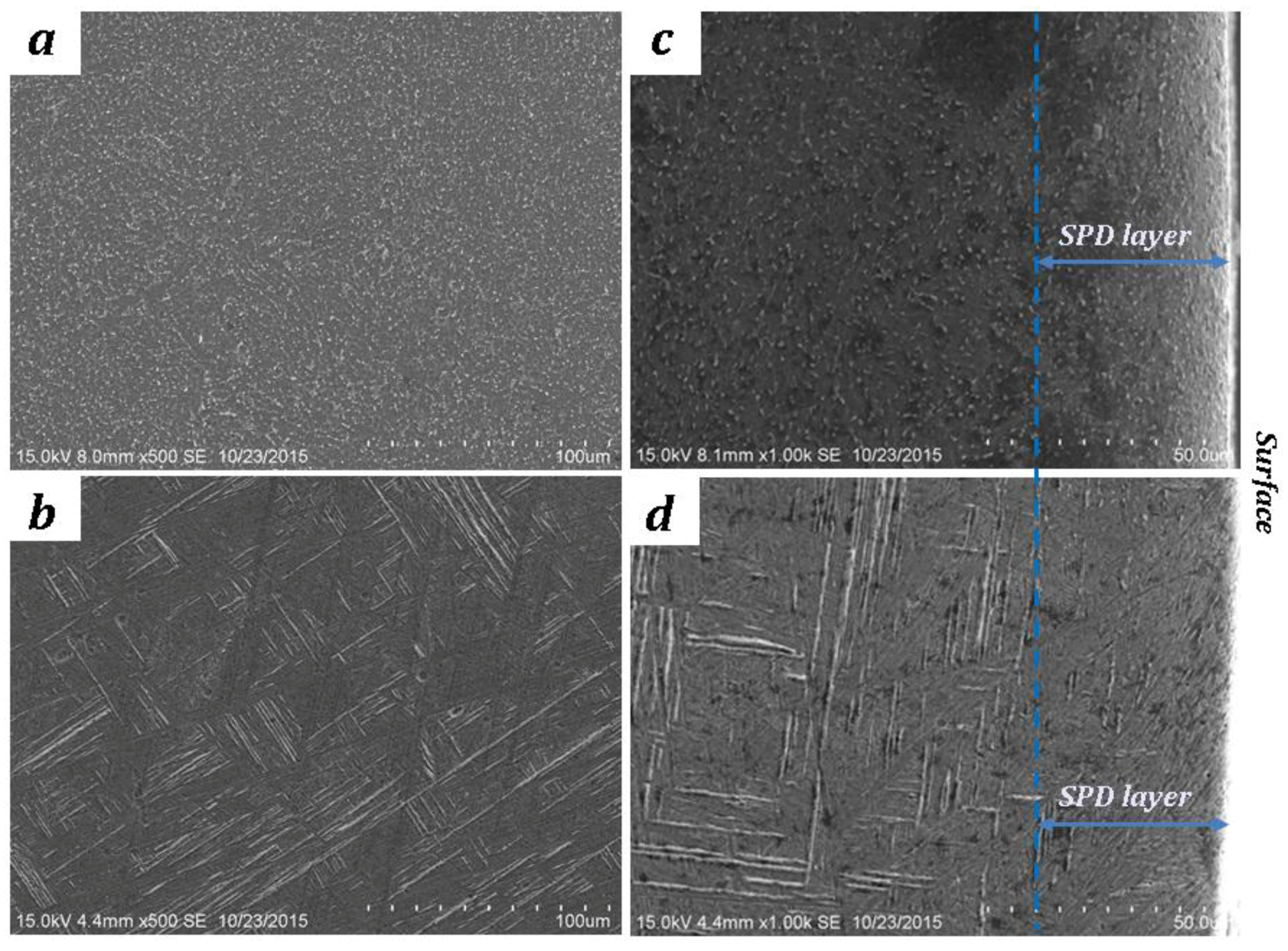
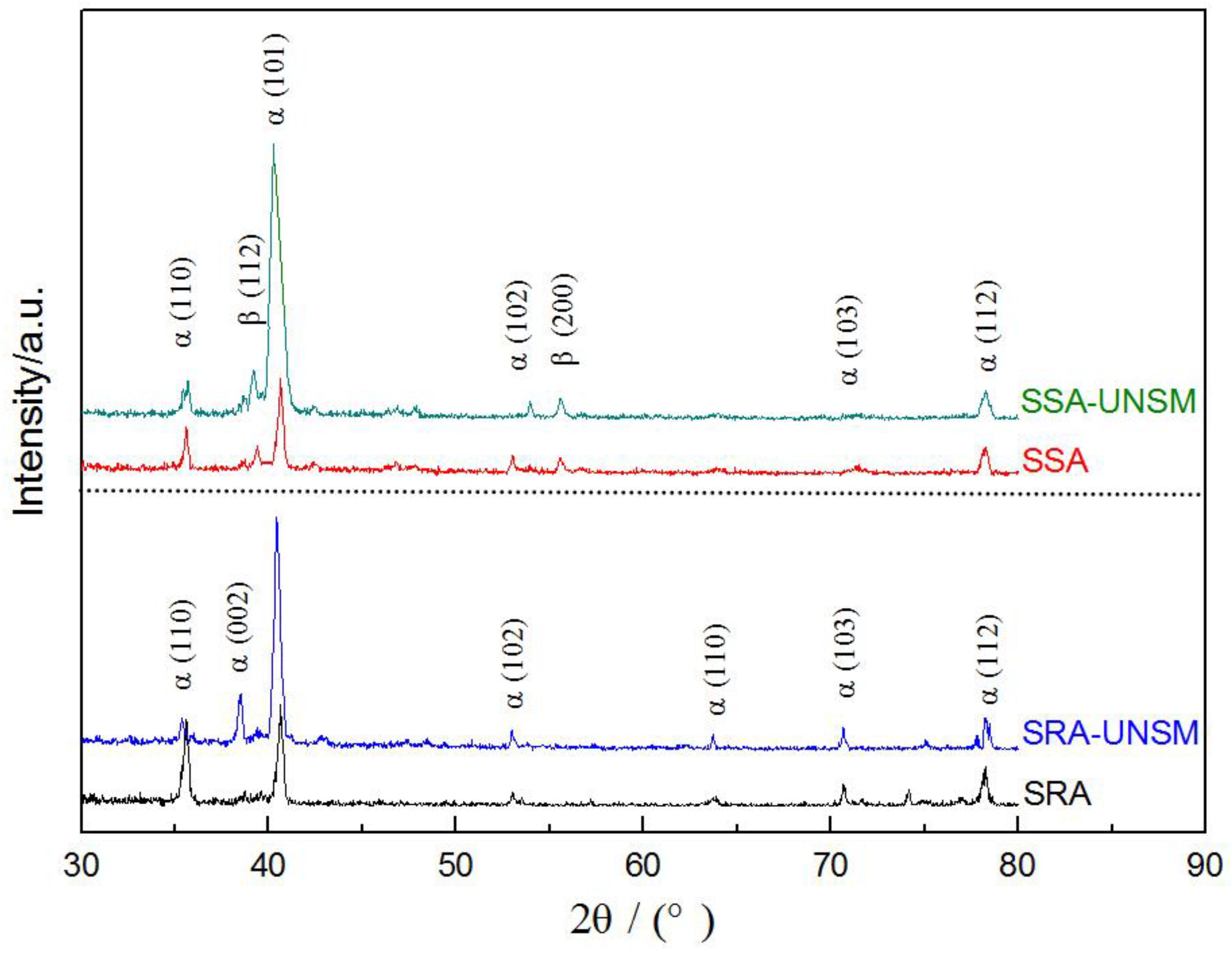
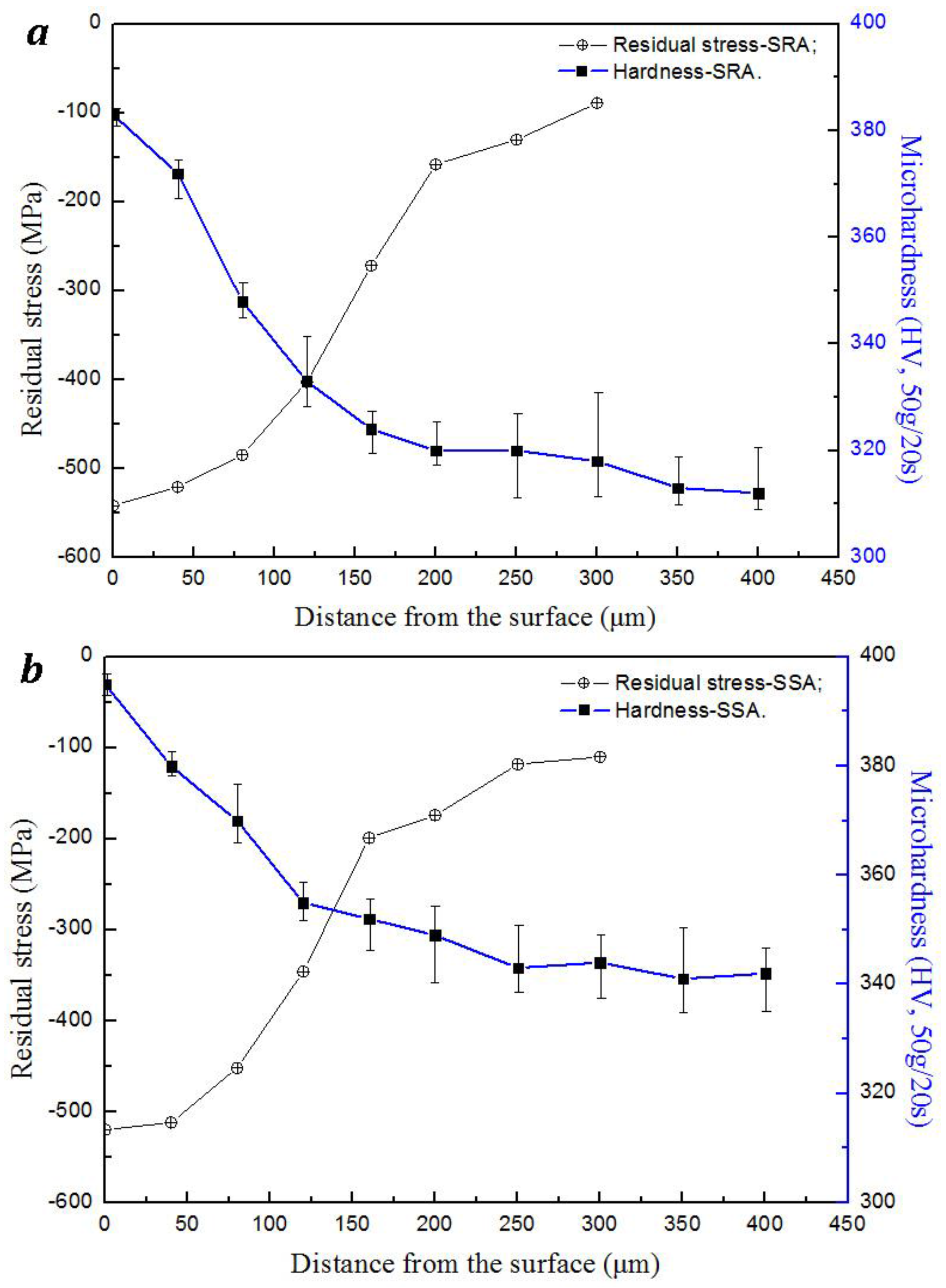
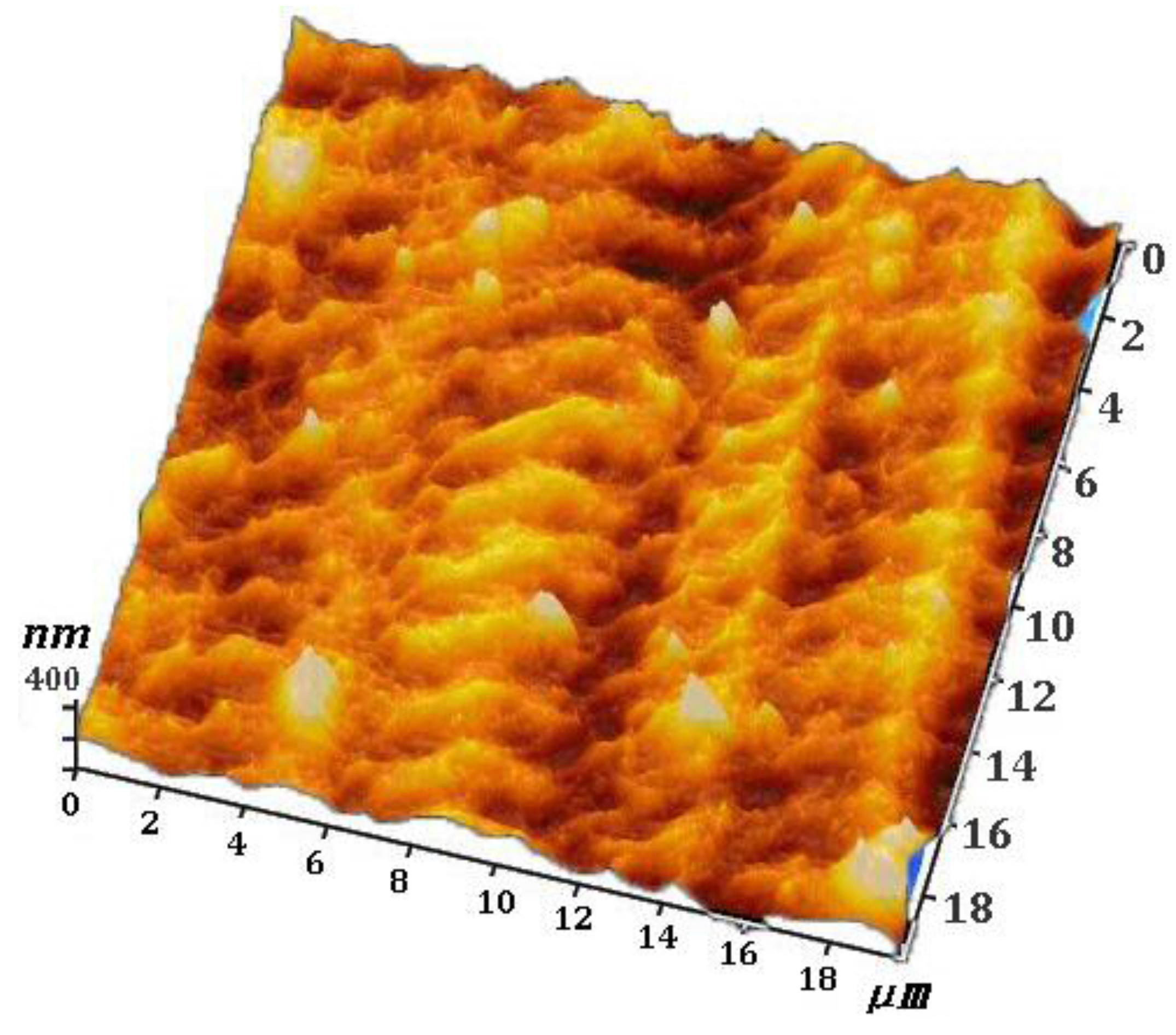
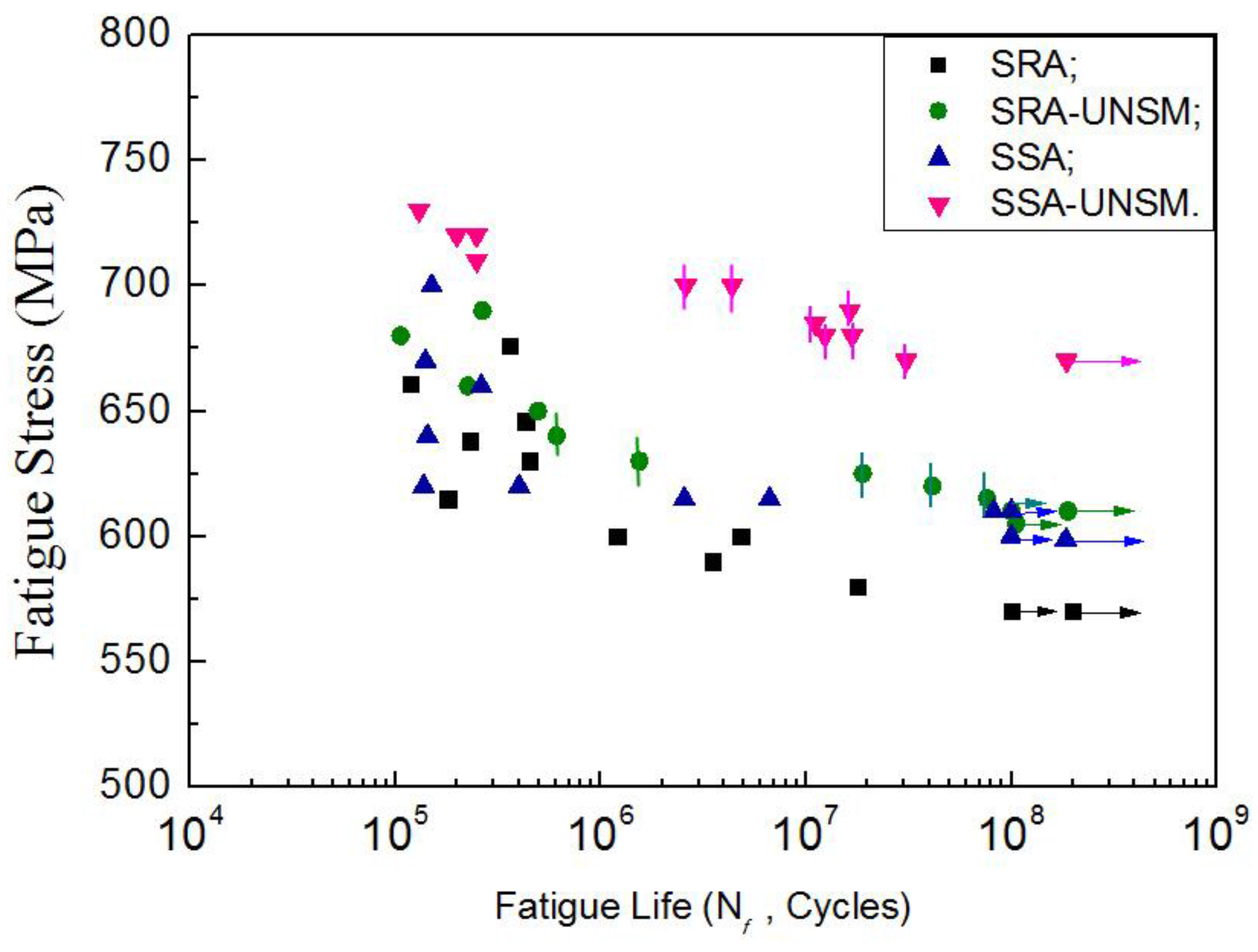
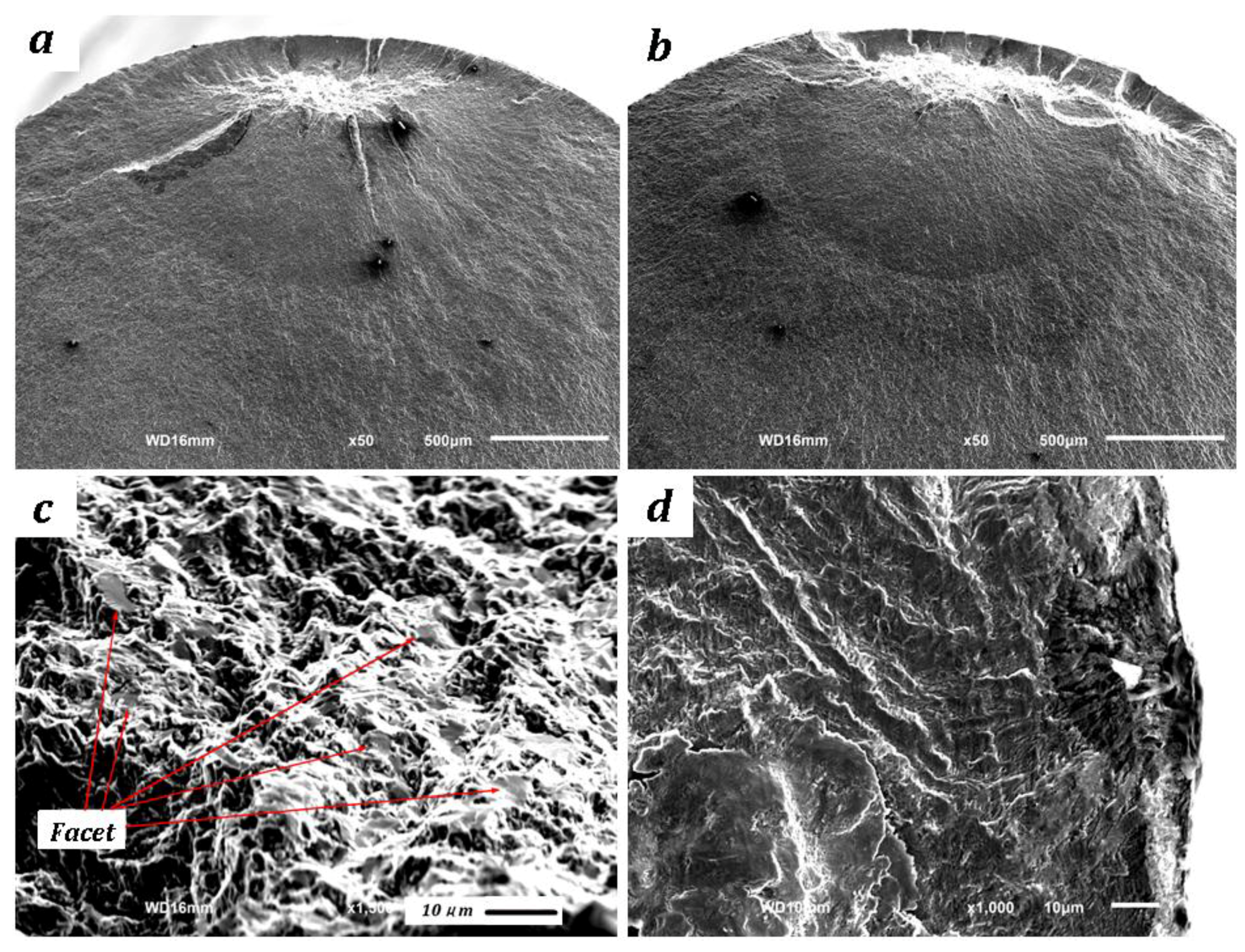
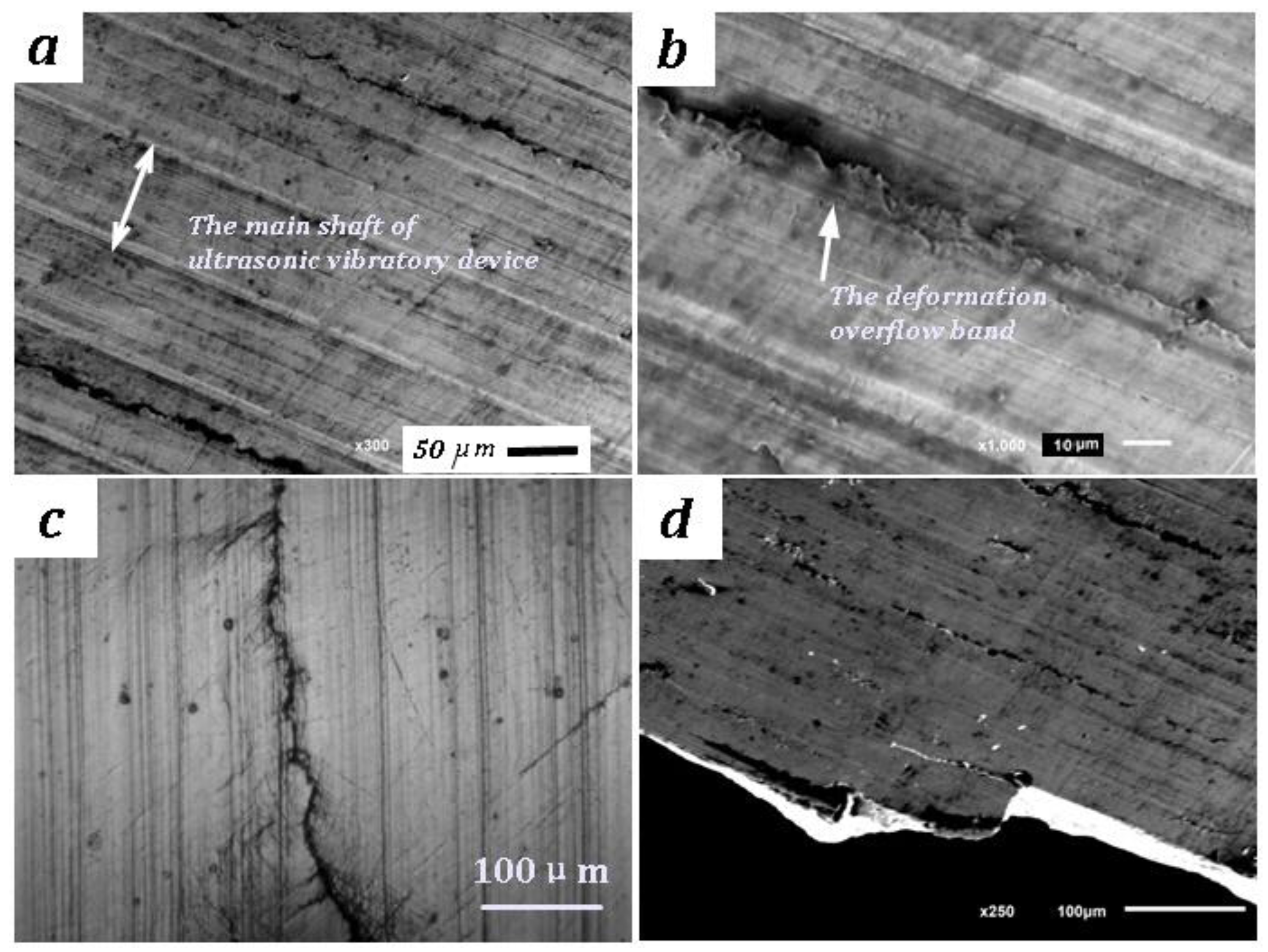
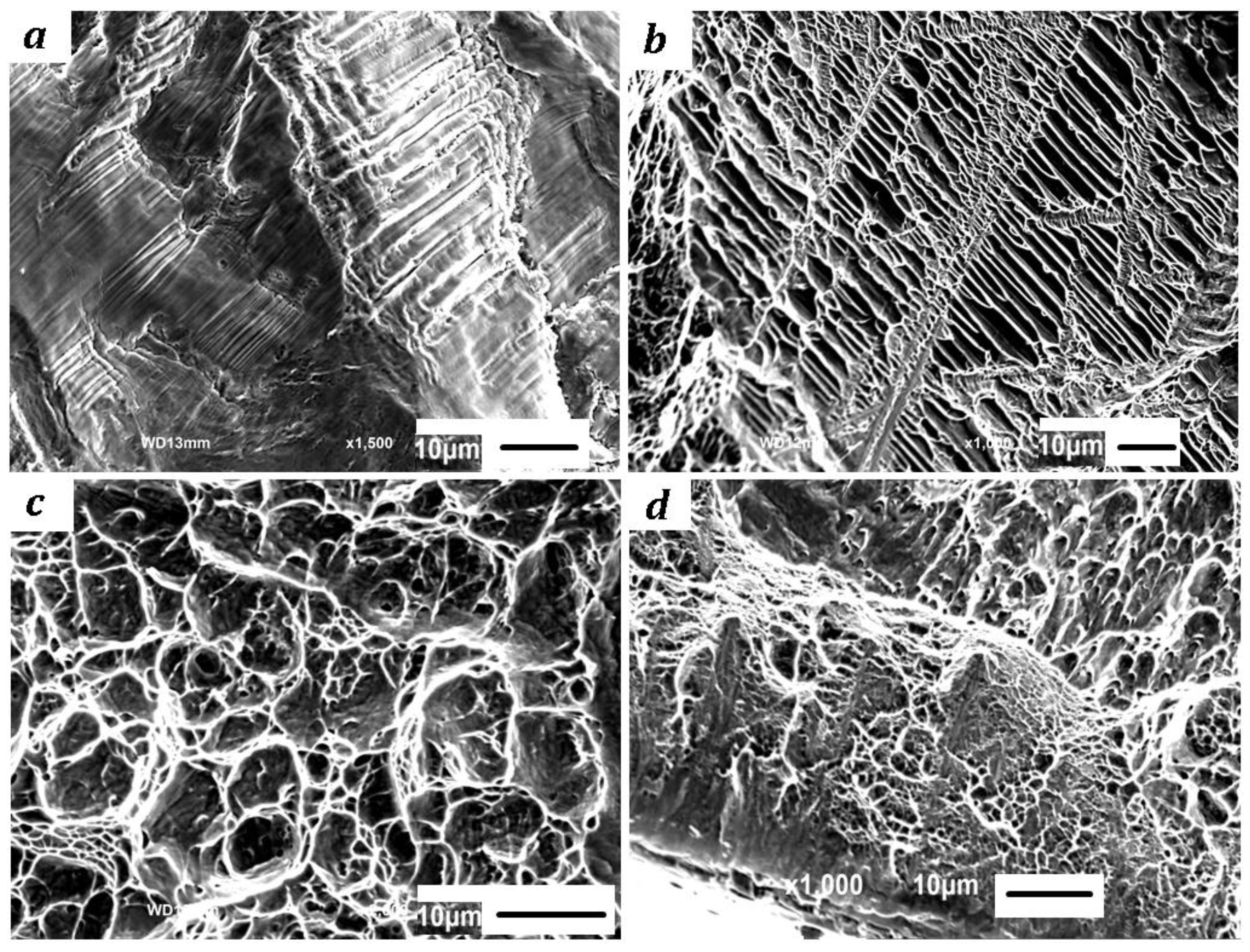
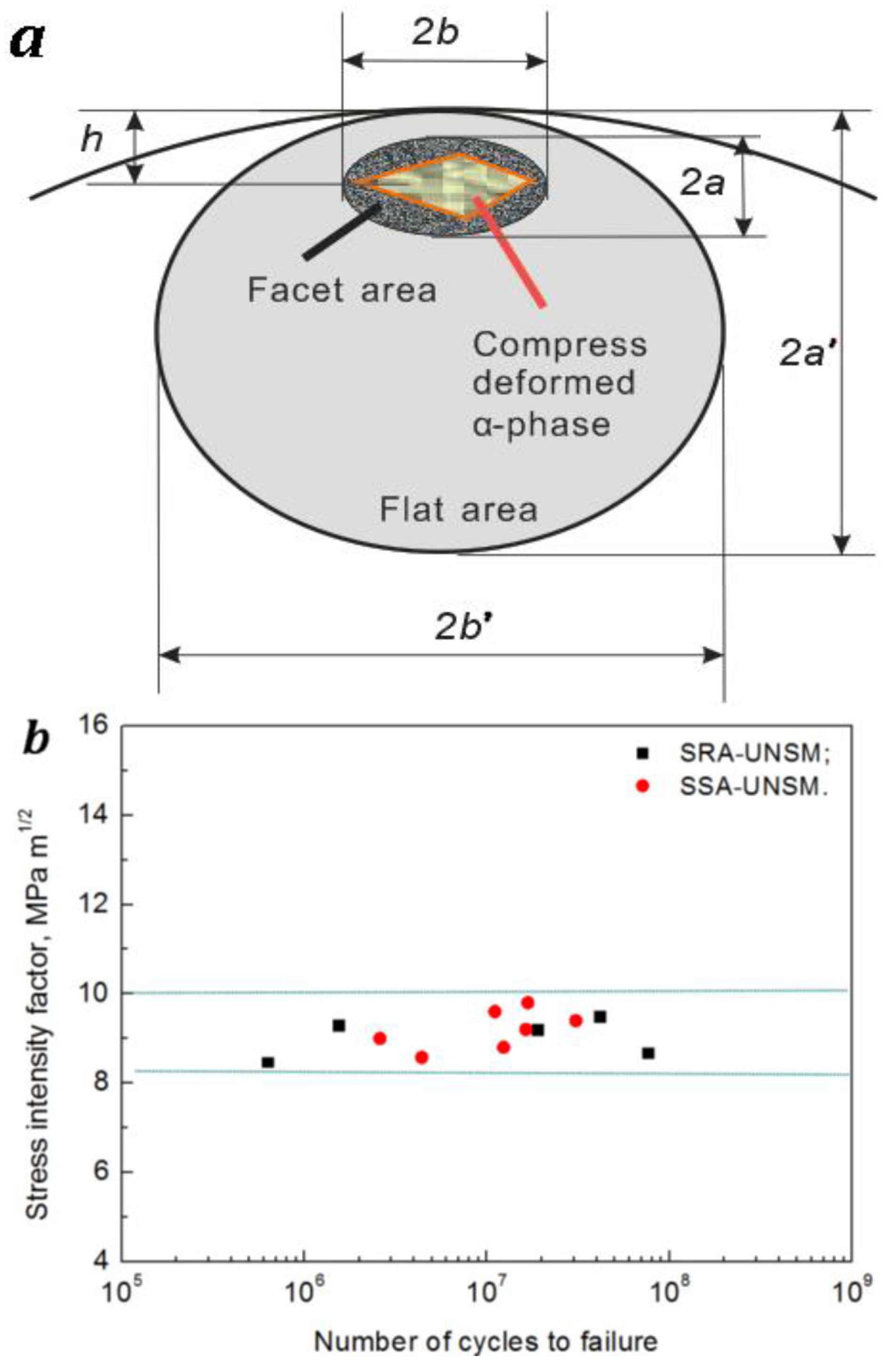
| Groups | SRA | SRA-UNSM | SSA | SSA-UNSM | |
|---|---|---|---|---|---|
| Treatments | |||||
| Stress-relief annealing | 〇 | 〇 | |||
| Solid solution and aging | 〇 | 〇 | |||
| With UNSM | 〇 | 〇 | |||
| Heat Treatment | σ0.2/MPa | σb/MPa | Elongation/% | Reduction of Area/% |
|---|---|---|---|---|
| Stress-relief annealing | 850 | 925 | 16 | 26 |
| Solid solution & aging | 1180 | 1230 | 14 | 10 |
| Group | SRA | SRA-NSM | SSA | SSA-UNSM |
|---|---|---|---|---|
| Roughness (Ra) | 0.35 μm | 0.5 μm | 0.39 μm | 0.58 μm |
© 2018 by the author. Licensee MDPI, Basel, Switzerland. This article is an open access article distributed under the terms and conditions of the Creative Commons Attribution (CC BY) license (http://creativecommons.org/licenses/by/4.0/).
Share and Cite
Cao, X.; Xu, L.; Xu, X.; Wang, Q. Fatigue Fracture Characteristics of Ti6Al4V Subjected to Ultrasonic Nanocrystal Surface Modification. Metals 2018, 8, 77. https://doi.org/10.3390/met8010077
Cao X, Xu L, Xu X, Wang Q. Fatigue Fracture Characteristics of Ti6Al4V Subjected to Ultrasonic Nanocrystal Surface Modification. Metals. 2018; 8(1):77. https://doi.org/10.3390/met8010077
Chicago/Turabian StyleCao, Xiaojian, Luopeng Xu, Xiaoli Xu, and Qingyuan Wang. 2018. "Fatigue Fracture Characteristics of Ti6Al4V Subjected to Ultrasonic Nanocrystal Surface Modification" Metals 8, no. 1: 77. https://doi.org/10.3390/met8010077





